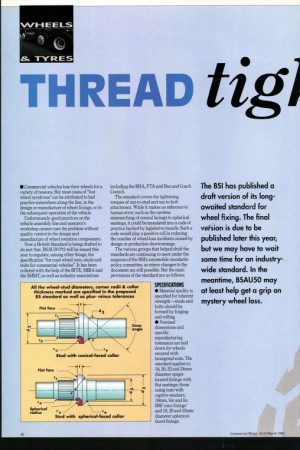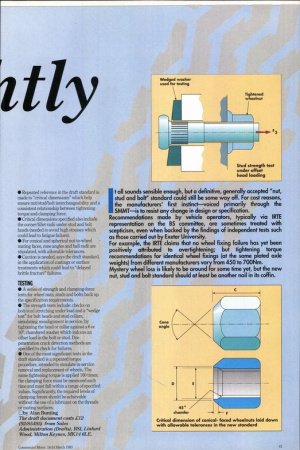THREAD- tigJ I t1)7
Page 42

Page 43

If you've noticed an error in this article please click here to report it so we can fix it.
The BSI has published a draft version of its longawaited standard for wheel fixing. The final version is due to be published later this year, but we may have to wait some time for an industrywide standard. In the meantime, BSAU50 may at least help get a grip on mystery wheel loss.
• Commercial vehicles lose their wheels for a variety of reasons. But most cases of "lost wheel syndrome"can be attributed to bad practice somewhere along the line, in the design or manufacture of wheel fixings, or in the subsequent operation of the vehicle.
Unfortunately good practices on the vehicle assembly line and operator's workshop cannot cure the problem without quality control in the design and manufacture of wheel retention components.
Now a British Standard is being drafted to do just that. BSAU50 Pt2 will be issued this year to regulate, among other things, the specification "for road-wheel nuts, studs and bolts for commercial vehicles". It has been collated with the help of the IRTE, MIRA and the SMMT, as well as industry associations including the RHA, FTA and Bus and Coach Council.
The standard covers the tightening torques of nut-to-stud and nut-to-bolt attachment. While it makes no reference to human error, such as the careless mismatching of conical facings to spherical seatings, it could be translated into a code of practice backed by legislative muscle. Such a code would play a positive roll in reducing the number of wheel-loss incidents caused by design or production shortcomings.
The various groups that helped draft the standards are continuing to meet under the auspices of the BSI's automobile standards policy committee, so minor changes to the document are still possible. But the main provisions of the standard are as follows: SPECIFICATIONS • Material quality is specified for inherent strength—studs and bolts should be formed by forging and rolling.
• Nominal dimensions and specific manufacturing tolerances are laid down for wheels secured with hexagonal nuts. The standard applies to: 18, 20, 22 and 24mm diameter spigotlocated fixings with flat seating's; those using nuts with captive washers; 18nun,3iin and lin BSF cone fixings' and 18,20 and 22mm diameter sphericalfaced fixings.
• Repeated reference in the draft standard is made to "critical dimensions" which help ensure nut/stud/bolt interchangeability and a consistent relationship between tightening torque and clamping force.
• Critical dimensions specified also include the corner/fillet radii under stud and bolt heads (needed to avoid high stresses which could lead to fatigue failure).
0-For conical and spherical nut-to-wheel mating faces, cone angles and ball radii are stipulated, with allowable tolerances.
• Caution is needed, says the draft standard, in the application of coatings or surface treatments which could lead to "delayed brittle fracture" failures.
TESTING • A series of strength and clamping-force tests for wheel nuts, studs and bolts back up the specification requirements.
• The strength tests include: checks on bolt/stud stretching under load and a "wedge test" for bolt heads and stud collars, simulating misalignment in service, by tightening the head or collar against a 6 or 10°, chamfered washer which induces an offset load in the bolt or stud. Dyepenetration crack detection methods are specified to check for failures.
• One of the most significant tests in the draft standard is a repeated torque procedure, intended to simulate in-service removal and replacement of wheels. The same tightening torque is applied 100 times; the clamping force must be measured each time and must fall within a range of specified values. Significantly, the required levels of clamping forces should be achievable without the use of a lubricant on the threads or mating surfaces.
Eby Alan Bunting The draft document costs 1'12 (92/85495) from Sales Administration (Drafts), BSI, Lin ford Wood, Milton Keynes, MK14 6LE.
It all sounds sensible enough, but a definitive, generally accepted "nut, stud and bolt" standard could still be some way off. For cost reasons, the manufacturers' first instinct—voiced primarily through the SMMT—is to resist any change in design or specification. Recommendations made by vehicle operators, typically via IRTE representation on the BS committee, are sometimes treated with scepticism, even when backed by the findings of independent tests such as those carried out by Exeter University.
For example, the IRTE claims that no wheel fixing failure has yet been positively attributed to overtightening; but tightening torque recommendations for identical wheel fixings (at the same plated axle weights) from different manufacturers vary from 450 to 700Nm.
Mystery wheel loss is likely to be around for some time yet, but the new nut, stud and bolt standard should at least be another nail in its coffin.




















































































